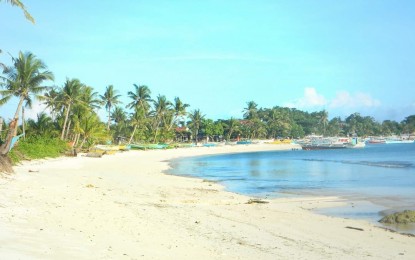
CONSERVATION. A portion of Suluan Island in Guiuan, Eastern Samar, forming part of the fishery management area in Eastern Visayas and Caraga. The Bureau of Fisheries and Aquatic Resources is pushing for the adoption of the newly-drafted municipal fisheries ordinance among local government units to attain sustainable management of several bays in Eastern Visayas and Caraga. (Photo from Suluan Island FB page)
TACLOBAN CITY – The Bureau of Fisheries and Aquatic Resources (BFAR) is pushing for the adoption of the newly-drafted municipal fisheries ordinance (MFO) among local government units (LGUs) to attain sustainable management of several bays in Eastern Visayas and Caraga regions.
BFAR Eastern Visayas director Juan Albaladejo, lead person for fisheries management area 8 (FMA 8), said in an interview Friday the model MFO aims to provide a real template that can be easily adopted on the ground by LGUs in coastal areas.
“This is to attain fisheries conservation and abundance in their respective municipal waters through a holistic and harmonized management approach within the FMA,” Albaladejo told the Philippine News Agency.
He called for the active involvement of the FMA 8 technical working group governance cluster members, especially the Department of the Interior and Local Government (DILG) in the two regions to refine the draft MFO presented and encourage LGUs to voluntarily adopt it.
FMA 8 covers the western coastline of Calicoan Island, northwestern coastline of Suluan Island, Siargao Island coastline, Lanuza Bay, Panaon Island coastline, and Samar Island coastline.
“Hopefully, it can be applied as a Joint Administrative Order, especially now that we are anticipating the implementation of the Mandanas-Garcia Supreme Court Ruling which will increase the IRA of the local government units. Thus, giving them an avenue to allot the necessary fund in the implementation of their Fisheries Development Plan,” he added.
Notable sections included in the draft MFO include utilization, management, development, conservation, and allocation system of fisheries and aquatic resources municipal fisheries development plan; enforcement of fishery laws, and rules and regulations.
The draft ordinance also outlines the construction and management of municipal fish ports; streamlining of registration and licensing of municipal fishers, municipal fishing vessels, and fishing gears; production zones; zoning of municipal waters and establishment of post-harvest facilities.
This proposed MFO is a product of the concerted effort of the BFAR, DILG, RARE Philippines, partner civil society organizations, fisheries, and aquatic resources management councils’ representatives, and municipal agriculture officers nationwide.
On Feb. 14, 2020, BFAR signed an agreement with Rare, Inc., with head office in Virginia, US to explore the possibilities of ensuring the preferential rights of municipal fisherfolk over the use of municipal water and replicating the establishment of managed access areas and reserves.
The national government has established 12 FMAs in the country through the issuance of BFAR Administrative Order 263. It seeks to provide a science-based and participatory governance framework for the management of these FMAs.
The seawater and lakes under the country’s territory have been grouped into 12 management areas. BFAR defines FMA as a bay, gulf, lake, or any other fishery area which may be delineated for fishery resource management purposes.
FMAs are delineated based on approximate stock boundaries, range, distribution, and structure.
The management board for each FMA is required to develop policies and programs for the area based on an ecosystems approach to fisheries management, as well as local government ordinances that will provide the governance framework for sustainable management of the FMA.
The FMA 8 envisions to be the first among the 12 areas to implement this model MFO once attuned, finalized, and approved through a resolution of its management body for a synchronized effort towards its sustainable and effective management. (PNA)
